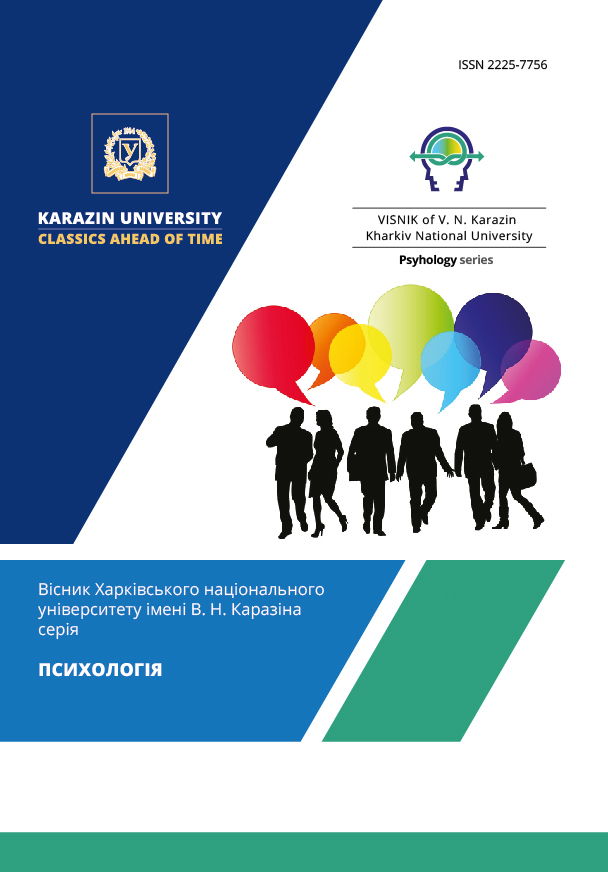Валідизація і вимірювальна інваріантність української версії шкали позитивних і негативних переживань (SPANE)
Анотація
В даному перехресному дослідженні було адаптовано та валідизовано українську версію Шкали позитивних і негативних переживань (SPANE). Вибірку склали 458 дорослих українців. Було проведено конфірматорний факторний аналіз. Він підтвердив двофакторну модель, в якій субшкали позитивного афекту (SPANE-P) і негативного афекту (SPANE-N) мають помірний зворотний зв’язок (r = -0,594). Композитна надійність склала 0,909 для SPANE-P і 0,861 для SPANE-N. Конвергентна валідність визначалася за індексом середньої вилученої дисперсії, яка склала 0,630 для SPANE-P і 0,533 для SPANE-N. Дискримінаційна валідність, що визначалася за методом Форнелла і Ларкера та за HTMT-критерієм, задовільна для обох субшкал SPANE. Отримані дані підтверджують строгу інваріантність вимірювання для віку і статі. Результати дослідження показали, що опитувальник має прийнятні психометричні якості.
Завантаження
Посилання
Brown, T. A. (2014). Confirmatory Factor Analysis for Applied Research. New York, NY: Guilford Publications.
Busseri, M. A. (2018). Examining the structure of subjective well-being through meta-analysis of the associations among positive affect, negative affect, and life satisfaction. Personality and Individual Differences, 122, 68–71. https://doi.org/10.1016/j.paid.2017.10.003
Chen, F. F. (2007). Sensitivity of goodness of fit indexes to lack of measurement invariance. Structural Equation Modeling, 14(3), 464–504. https://doi.org/10.1080/10705510701301834
Diener, E. (1984). Subjective well-being. Psychological Bulletin, 95(3), 542–575. https://doi.org/10.1037/0033-2909.95.3.542
Diener, E. D., Emmons, R. A., Larsen, R. J., Griffin, S. (1985). The satisfaction with life scale. Journal of Personality Assessment, 49(1), 71–75. https://doi.org/10.1207/s15327752jpa4901_13
Diener, E., Oishi, S., & Tay, L. (2018). Advances in subjective well-being research. Nature human behaviour, 2(4), 253–260. https://doi.org/10.1038/s41562-018-0307-6
Diener, E., Wirtz, D., Tov, W., Kim-Prieto, C., Choi, D.-w., Oishi, S., & Biswas-Diener, R. (2010). New well-being measures: Short scales to assess flourishing and positive and negative feelings. Social Indicators Research, 97(2), 143–156. https://doi.org/10.1007/s11205-009-9493-y
Espejo, B., Checa, I., Perales-Puchalt, J. & Lison, J. F. (2020). Validation and measurement invariance of the Scale of Positive and Negative Experience (SPANE) in a Spanish general sample. International Journal of Environmental Research and Public Health, 17(22), 8359. https://doi.org/10.3390/ijerph17228359
Flora, D. B. (2020). Your coefficient alpha is probably wrong, but which coefficient omega is right? A tutorial on using R to obtain better reliability estimates. Advances in Methods and Practices in Psychological Science, 3(4), 484–501. https://doi.org/10.1177/2515245920951747
Hair, J., Hult, T., Ringle, C., & Sarstedt, M. (2016). A Primer on Partial Least Squares Structural Equation Modeling (PLS-SEM) (2nd ed.). Thousand Oaks, CA: Sage Publications.
Henseler, J., Ringle, C. M., Sarstedt, M. (2015). A new criterion for assessing discriminant validity in variance-based structural equation modeling. Journal of the Academy of Marketing Science. 43, 115–135. https://doi.org/10.1007/s11747-014-0403-8
Jovanović, V. (2015). Beyond the PANAS: Incremental validity of the Scale of Positive and Negative Experience (SPANE) in relation to well-being. Personality and Individual Differences, 86, 487–491. https://doi.org/10.1016/j.paid.2015.07.015
Jovanović, V., Joshanloo, M., Martín-Carbonell, M., Caudek, C., Espejo, B., Checa, I., Krasko, J., Kyriazos, T., Piotrowski, J., Rice, S., Junça Silva, A., Singh, K., Sumi, K., Tong, K. K., Yıldırım, M., & Żemojtel-Piotrowska, M. (2021). Measurement Invariance of the Scale of Positive and Negative Experience Across 13 Countries. Assessment, 10731911211021494. Advance online publication. https://doi.org/10.1177/10731911211021494
Jovanović, V., Lazić, M., Gavrilov-Jerković, V., & Molenaar, D. (2020). The Scale of Positive and Negative Experience (SPANE): Evaluation of measurement invariance and convergent and discriminant validity. European Journal of Psychological Assessment. 2020. № 4. P. 694–704. https://doi.org/10.1027/1015-5759/a000540
Klimanska, M. B., Haletska, I. I. (2020). Psychometric characteristics of the questionnaire on positive and negative affects (OPANA), based on the PANAS scales. Psychological journal, 6(4). 119-132. https://doi.org/10.31108/1.2020.6.4.10
Li, F., Bai, X., & Wang, Y. (2013). The Scale of Positive and Negative Experience (SPANE): Psychometric properties and normative data in a large Chinese Sample. PLoS ONE, 8(4), e61137. https://doi.org/10.1371/iournal.pone.0061137
Linton, M., Dieppe, P., & Medina-Lara, A. (2016). Review of 99 self-report measures for assessing well-being in adults: Exploring dimensions of well-being and developments overtime. BMJ Open, 6(7), [e010641]. https://doi.org/10.1136/bmjopen-2015-010641
Maddux, J. E. (2018). Subjective well-being and life satisfaction: An introduction to conceptions, theories, and measures. In J. E. Maddux (Ed.), Subjective well-being and life satisfaction (pp. 3–31). Routledge/Taylor & Francis Group.
Olefir, V. O. (2015). Intellectual-personality potential of self-regulation of the subject of activity [Monograph]. Kharkiv: UIPA. [In Ukraine]
Rahm, T., Heise, E., & Schuldt, M. (2017). Measuring the frequency of emotions – validation of the Scale of Positive and Negative Experience (SPANE) in Germany. PLoS ONE, 12(2), e0171288. https://doi.org/10.1371/iournal.pone.0171288
Ryff, C., & Keyes, C. (1995). The structure of psychological well-being revisited. Journal of Personality and Social Psychology, 69, 719–727. https://doi:10.1037/0022-3514.69.4.719
Scheier, M. F., Carver, C. S., & Bridges, M. W. (1994). Distinguishing optimism from neuroticism: A revaluation of the Life Orientation Test. Journal of Personality and Social Psychology, 67, 1063–1078. https://doi.org/1.1037/0022-3514.67.6.1063
Schumacker, R. E., Lomax, R. G. (2016). A beginner’s guide to structural equation modeling. (4rd. ed.). New York, NY: Routledge.
Singh, K., Junnarkar, M., & Jaswal, S. (2016). Validating the Flourishing Scale and the Scale of Positive and Negative Experience in India. Mental Health, Religion & Culture, 19(8), 943–954. https://doi.org/10.1080/13674676.2016.1229289
Vandenberg, R. J., & Lance, C. E. (2000). A review and synthesis of the measurement invariance literature: Suggestions, practices, and recommendations for organizational research. Organizational Research Methods, 3(1), 4–69. https://doi.org/10.1177/109442810031002
Watson, D., Clark, L. A., & Tellegen, A. (1988). Development and validation of brief measures of positive and negative affect: The PANAS scales. Journal of Personality and Social Psychology, 54(6), 1063–1070. https://doi.org/10.1037/0022-3514.54.6.1063




